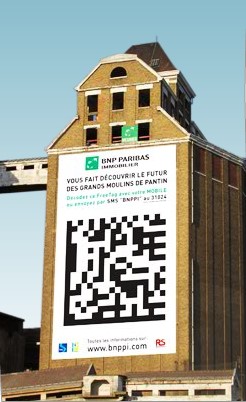The Bridge Between Atoms and Bits: 2D Code
If you live in Japan or Korea, this kind of symbol will be familar.

It’s so ubiquitous in Asia you can find it on McDonald’s packaging. The patch is a 2d barcode, or QR code, that can be read by a cell phone camera. You point your phone towards the symbol which could be on a billboard, or a building, or hamburger packaging, and your phone will then provide a decipherment of the data. The following McDonalds commercial in Japanese show how to use the codes.
As mobile phone life takes root in the US, we’ll see more of these, particularly for location-based services. It is a cheap way to signal some simple information to the mobile web. Indeed, a good way to think of QR and 2D codes is a bridge between atoms and bits, between the real world and the digital world. You want something physical to meet something virtual? Print up a simple sticker.
The problem so far is that there are more then 40 competing designs for 2d coding. Most are variations on black and white patterns, but a few even use color. QR is one popular codex in Japan, but there are others, like Shotcode.
My guess is that the huge pool of contenders for this standard means that there is little consensus on what kind of information we expect to convey with the phone codes. Will it be very simple latitude/longitude information? Or mostly product SKUs and website URLs? Or more complex data?
To keep up on this volitle frontier, there’s the blog 2d code, which avidly follows all manner of 2d and QR code.

